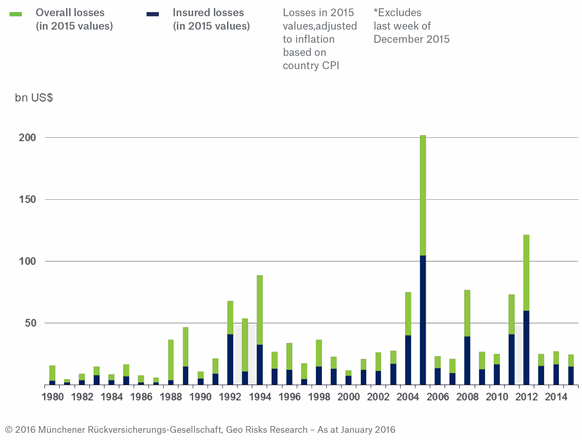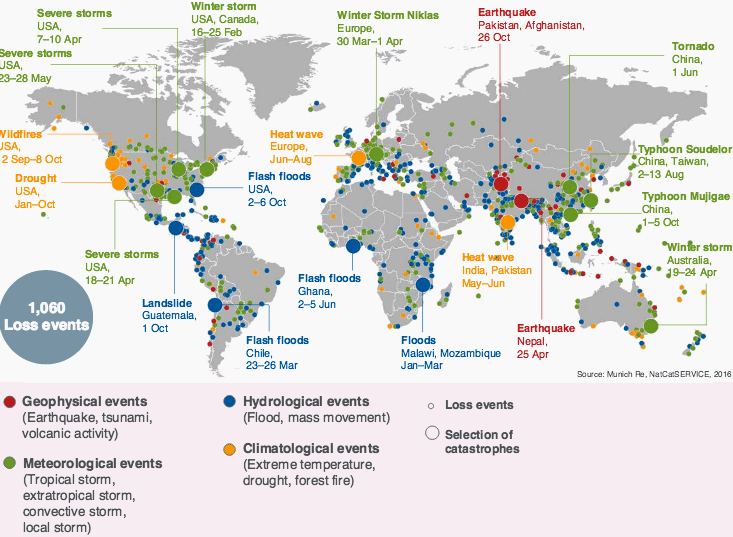Losses from natural catastrophes in 2015 resulted in just $27 billion of impact to the insurance and reinsurance industry, according to Munich Re, lower than the figure seen in 2014 and the lowest since 2009.
Global reinsurance firm Munich Re noted this morning that the re/insurance sector will find no solace in catastrophe loss figures for 2015 once again, as the continued low levels of financial impact mean there is little stimulus to raise rates.

Catastrophe loss events 1980 - 2015. Overall and insured losses*
Of course lower losses is good for society, meaning a lower impact to lives and livelihood from natural disasters and severe weather events. But for the reinsurance industry which is battling with continued rate softening, as seen at the latest January reinsurance renewals, the lack of catastrophes has exacerbated the rate decline and helped to ramp up competition due to high levels of excess capital in the industry.
However the reduction in insured losses has outpaced the decline in economic losses from natural catastrophes in 2015, suggesting that losses have occurred in regions with lower insurance penetration. The ideal scenario is to bring the insurance loss figure as close to the economic loss as possible, ensuring more lives and livelihoods are protected.
“In terms of financial losses, we were somewhat fortunate in 2015: Strong tropical cyclones frequently only hit sparsely populated areas or did not make landfall at all. In the North Atlantic, El Niño helped to curtail the development of heavy storms. Measures to reduce loss susceptibility have also had a positive effect,” Peter Höppe, Head of Munich Re’s Geo Risks Research Unit explained.
El Niño resulted in reduced hurricane activity in the North Atlantic, but at the same time brought major floods and heatwaves to many developing and emerging countries. However, as El Niño conditions wane it is possible that insurers and reinsurers may see an uptick in events that do cause greater losses.
Höppe continued; “Scientists believe that in the coming year the strong El Niño phase might be followed by its twin sister, La Niña. Both versions of the climate oscillation ENSO (El Niño/Southern Oscillation) in the Pacific influence weather extremes throughout the world. A La Niña phase would promote the development of hurricanes in the North Atlantic, for example.”
Munich Re provides some data on 2015’s catastrophe losses:
- 2015 saw the lowest losses of any year since 2009. Overall losses totalled US$ 90bn (previous year US$ 110bn), of which only US$ 27bn (US$ 31bn) was insured.
- The loss amounts were also below the long-term inflation-adjusted average for the period 1985–2014 (overall losses US$ 130bn, insured losses US$ 34bn). Insured losses were therefore roughly 20% below the average.
- The natural catastrophes of the past year claimed 23,000 lives, substantially more than the previous year’s figure of 7,700. However, the number of victims was still some way below the annual average for the last 30 years (54,000).
- For the first time, more than a thousand loss events were recorded in a single year. However, this is primarily due to improved communication of such events. In particularly benign years, a lot of minor events are recorded.
Torsten Jeworrek, member of Munich Re’s Board of Management, noted that the gap between economic and insured losses remains wide; “Just like in Nepal, the proportion of insured losses for catastrophes in other developing and emerging countries remains very low. The insurance industry is exploring new avenues to close this gap in cover and thus to help people better cope with material losses after a catastrophe.”
Jeworrek noted that catastrophe insurance facilities such as the Caribbean Catastrophe Risk Insurance Facility (CCRIF), Pacific Catastrophe Risk Assessment & Finance Initiative (PCRAFI) and African Risk Capacity (ARC) can be expected to help to narrow this gap over time.
“These are pioneering solutions, especially as they also permit insurance for the countries that suffer most from the consequences of climate change, but have thus far not been able to organise cover,” he explained.
The costliest natural catastrophe for the insurance and reinsurance industry in 2015 was the severe cold in the U.S. winter once again. A series of winter storms that struck the northeastern United States and Canada in February resulted in insured losses of $2.1 billion, with overall losses hitting $2.8 billion.
Across the whole of the 2014/2015 winter the impact to the U.S. on both an economic and insured basis was higher than the previous winter, with $4.6 billion of overall losses and the insurance and reinsurance industry paying for $3.4 billion (up from $2.5 billion of insured losses in winter 2013/2014).
The five largest catastrophe events by insured losses for 2015 can be seen below:
 View all of our Artemis Live video interviews and subscribe to our podcast.
View all of our Artemis Live video interviews and subscribe to our podcast.
All of our Artemis Live insurance-linked securities (ILS), catastrophe bonds and reinsurance video content and video interviews can be accessed online.
Our Artemis Live podcast can be subscribed to using the typical podcast services providers, including Apple, Google, Spotify and more.

Five largest natural catastrophe losses ranked by insured losses

World map of 2015 natural catastrophe loss events































